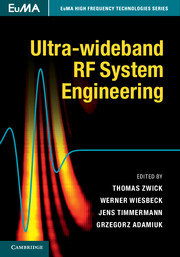6 - UWB applications
Published online by Cambridge University Press: 05 December 2013
Summary
In this chapter typical UWB applications are presented and discussed, particularly regarding their RF system design.
UWB communication
Modeling of the system components
The system model for impulse radio transmission consists of the transmitter, the UWB indoor channel and the receiver, see Fig. 6.1. At the transmitter side, the pulse generator creates pulses at moments defined by the pulse position modulation (PPM) scheme and the time-hopping (TH) code. Without modulation and coding, pulses appear at multiples of the pulse repetition time T. To modulate the signal by PPM, the binary values of the bit stream determine whether a constant delay TPPM is introduced or not with respect to the pulse repetition time.
The TH code adds a further pseudo-random delay to smooth the spectrum. This code must also be known at the receiver to demodulate the signal. To ensure that the radiated signal does not violate the spectral mask, an analog transmit bandpass filter is placed before the transmit antenna. The radiated signal propagates via an indoor radio channel including AWGN towards the receive antenna. It is then amplified, filtered and demodulated; different demodulation schemes are available. The following subsections describe the modeling of the non-ideal system components.
Pulse shape generator
Classical considerations emphasize the idea that impulse radio is a low-cost technique because of its simplified hardware architecture. For example, there is no necessity to use up-converters, since signals are radiated in the baseband. To remain low cost, the associated pulse shapes result from low complexity devices.
Information
- Type
- Chapter
- Information
- Ultra-wideband RF System Engineering , pp. 116 - 170Publisher: Cambridge University PressPrint publication year: 2013
